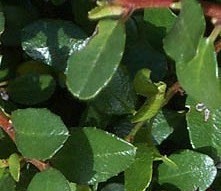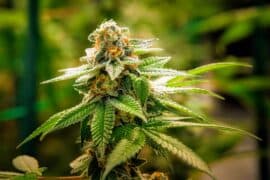Hollyleaf redberry
(Endotropis crocea ilicifolia)

Description
Rhamnus ilicifolia is a species of flowering plant in the buckthorn family known by the common name hollyleaf redberry. It is native to western North America, where it is a common plant growing in many types of habitat, including chaparral and wooded areas, from Oregon through California, to Baja California and Arizona. Rhamnus ilicifolia is a rambling shrub approaching four meters in maximum height. The thick leaves are oval to rounded with rounded tips, measuring 2 to 4 centimeters long. The edges are spiny-toothed and curve under, making the leaves concave. The inflorescence is a solitary flower or umbel of up to six flowers. The flower has four pointed sepals and no petals. The fruit is a drupe which ripens to bright shiny red. It is just under a centimeter wide and contains two seeds. Rhamnus is a genus of about 110 accepted species of shrubs or small trees, commonly known as buckthorns, in the family Rhamnaceae. Its species range from 1 to 10 m (3 to 33 ft) tall (rarely to 15 m, 50 ft) and are native mainly in east Asia and North America, but found throughout the temperate and subtropical Northern Hemisphere, and also more locally in the subtropical Southern Hemisphere in parts of Africa and South America. One species, the common buckthorn (Rhamnus cathartica), is able to flourish as an invasive plant in parts of Canada and the U.S., where it has become naturalized. Both deciduous and evergreen species occur. The leaves are simple, 3 to 15 cm (1 to 6 in) long, and arranged alternately, in opposite pairs, or almost paired (subopposite). One distinctive character of many buckthorns is the way the veination curves upward towards the tip of the leaf. The plant bears fruits which are black or red berry-like drupes. The name is due to the woody spine on the end of each twig in many species. One species is known to have potential to be used medicinally. Rhamnus species are shrubs or small to medium-sized trees, with deciduous or rarely evergreen foliage. Branches are unarmed or end in a woody spine. The leaf blades are undivided and pinnately veined. Leaf margins are serrate or rarely entire. Rhamnus species are generally dioecious, with male and female flowers on separate plants. Most species have yellowish green, small, unisexual or rarely polygamous flowers; which are produced singly or in axillary cymes, cymose racemes, or cymose panicles containing a few flowers.
Taxonomic tree:







